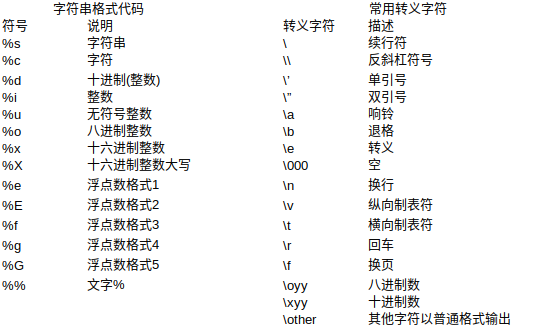一:%用法
1、整数输出
%o —— oct 八进制
%d —— dec 十进制
%x —— hex 十六进制
print('%o' % 20) # 24 print('%d' % 20) # 20 print('%x' % 20) # 14
2、浮点数输出
%f ——保留小数点后面六位有效数字
%.3f,保留3位小数位
%e ——保留小数点后面六位有效数字,指数形式输出
%.3e,保留3位小数位,使用科学计数法
%g ——在保证六位有效数字的前提下,使用小数方式,否则使用科学计数法
%.3g,保留3位有效数字,使用小数或科学计数法
print('%f' % 1.11) # 默认保留6位小数 1.110000 print('%.1f' % 1.11) # 取1位小数 1.1 print('%e' % 1.11) # 默认6位小数,用科学计数法 1.110000e+00 print('%.3e' % 1.11) # 取3位小数,用科学计数法 1.110e+00 print('%g' % 1111.1111) # 默认6位有效数字 1111.11 print('%.7g' % 1111.1111) # 取7位有效数字 1111.111 print('%.2g' % 1111.1111) # 取2位有效数字,自动转换为科学计数法 1.1e+03
3、字符串输出
%s
%10s——右对齐,占位符10位
%-10s——左对齐,占位符10位
%.2s——截取2位字符串
%10.2s——10位占位符,截取两位字符串
print('%s' % 'hello world') # 字符串输出 hello world print('%20s' % 'hello world') # 右对齐,取20位,不够则补位 hello world print('%-20s' % 'hello world') # 左对齐,取20位,不够则补位 hello world print('%.2s' % 'hello world') # 取2位 he print('%10.2s' % 'hello world') # 右对齐,取2位 he print('%-10.2s' % 'hello world') # 左对齐,取2位 he
4、其他
二:format用法
相对基本格式化输出采用‘%’的方法,format()功能更强大,该函数把字符串当成一个模板,通过传入的参数进行格式化,并且使用大括号‘{}’作为特殊字符代替‘%’
1、位置匹配
(1)不带编号,即“{}”
(2)带数字编号,可调换顺序,即“{1}”、“{2}”
(3)带关键字,即“{a}”、“{tom}”
print('{} {}'.format('hello','world')) # 不带字段 hello world print('{0} {1}'.format('hello','world')) # 带数字编号 hello world print('{0} {1} {0}'.format('hello','world')) # 打乱顺序 hello world hello print('{1} {1} {0}'.format('hello','world')) # world world hello print('{a} {tom} {a}'.format(tom='hello',a='world')) # 带关键字 world hello world # 通过位置匹配 print('{0}, {1}, {2}'.format('a', 'b', 'c')) # a, b, c print('{}, {}, {}'.format('a', 'b', 'c')) # 3.1+版本支持 a, b, c print('{2}, {1}, {0}'.format('a', 'b', 'c')) # c, b, a print('{2}, {1}, {0}'.format(*'abc')) # 可打乱顺序 c, b, a print('{0}{1}{0}'.format('abra', 'cad')) # 可重复 abracadabra # 通过类的属性匹配 class Point: def __init__(self, x, y): self.x, self.y = x, y def __str__(self): return 'Point({self.x}, {self.y})'.format(self=self) print(str(Point(4, 2))) # Point(4, 2) # 通过下标或者key匹配参数 coord = (3, 5) print('X: {0[0]}; Y: {0[1]}'.format(coord)) # X: 3; Y: 5 a = {'a': 'test_a', 'b': 'test_b'} print('X: {0[a]}; Y: {0[b]}'.format(a)) # X: test_a; Y: test_b
2、格式转换
‘b’ – 二进制。将数字以2为基数进行输出。
‘c’ – 字符。在打印之前将整数转换成对应的Unicode字符串。
‘d’ – 十进制整数。将数字以10为基数进行输出。
‘o’ – 八进制。将数字以8为基数进行输出。
‘x’ – 十六进制。将数字以16为基数进行输出,9以上的位数用小写字母。
‘e’ – 幂符号。用科学计数法打印数字。用’e’表示幂。
‘g’ – 一般格式。将数值以fixed-point格式输出。当数值特别大的时候,用幂形式打印。
‘n’ – 数字。当值为整数时和’d’相同,值为浮点数时和’g’相同。不同的是它会根据区域设置插入数字分隔符。
‘%’ – 百分数。将数值乘以100然后以fixed-point(‘f’)格式打印,值后面会有一个百分号。
print('{0:b}'.format(3)) # 11 print('{:c}'.format(20)) # print('{:d}'.format(20)) # 20 print('{:o}'.format(20)) # 24 print('{:x}'.format(20)) # 14 print('{:e}'.format(20)) # 2.000000e+01 print('{:g}'.format(20.1)) # 20.1 print('{:f}'.format(20)) # 20.000000 print('{:n}'.format(20)) # 20 print('{:%}'.format(20)) # 2000.000000%
3、format变形用法
# f"xxxx" # 可在字符串前加f以达到格式化的目的,在{}里加入对象,此为format的另一种形式: a = "hello" b = "world" print(f"{a} {b}") name = 'jack' age = 18 sex = 'man' job = "IT" salary = 9999.99 print(f'my name is {name.capitalize()}.') # my name is Jack. print(f'I am {age:*^10} years old.') # I am ****18**** years old. print(f'I am a {sex}') # I am a man print(f'My salary is {salary:10.3f}') # My salary is 9999.990
今天的文章string的format用法_格式化输出字符串分享到此就结束了,感谢您的阅读,如果确实帮到您,您可以动动手指转发给其他人。
版权声明:本文内容由互联网用户自发贡献,该文观点仅代表作者本人。本站仅提供信息存储空间服务,不拥有所有权,不承担相关法律责任。如发现本站有涉嫌侵权/违法违规的内容, 请发送邮件至 举报,一经查实,本站将立刻删除。
如需转载请保留出处:http://bianchenghao.cn/45017.html

